What Is a Help Desk? Benefits, Key Features, Roles, How to Setup
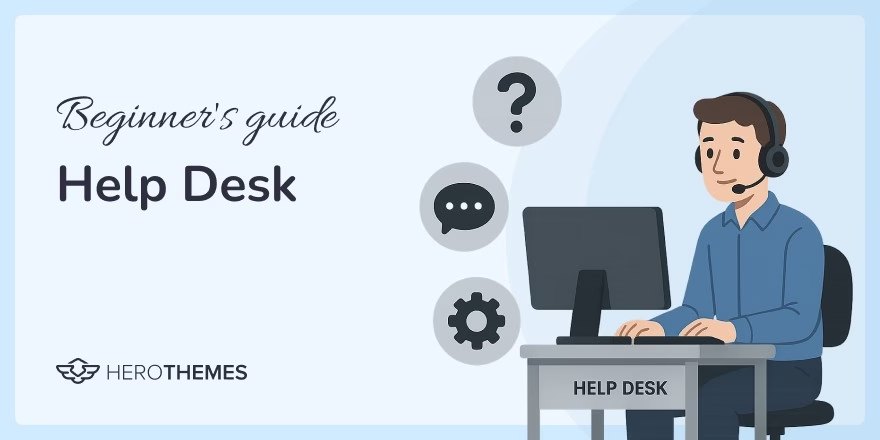
What is a help desk? its system designed to assist customers or employees with IT systems, software, or services.
If you need to offer support to your customers (or any other group of people, like employees), a help desk is a great way to improve and streamline your communications.
In this article, we’ll explore the key features in a help desk, the benefits of adding a help desk to your business, and how you can get started with your very own help desk.
Let’s dig in!
In This Guide

We rigorously test and research every product that we recommend through HeroThemes. Our review process. We may also earn a commission if you make a purchase through our links.
What Is Help Desk?
A help desk is a centralized system designed to assist internal and external users—whether customers or employees—who need help with IT systems, software, hardware, or other services.
It acts as a resource for users to find solutions to their queries. Providing help desk support is an essential strategy for your customer support team to serve buyers and provide a seamless customer experience.
Help desk system generally divided into two types:
Internal help desk: An internal help desk facilitates problem-solving within a company. For example:
- HR support – It guides orientation, employee exit, and HR complaint procedures.
- Facilities support – This help desk handles issues related to workplace amenities and logistics.
- IT support – An IT service desk takes care of technical grievances related to software and hardware.
Explore:
What is IT help desk support, and how does it work
How to Create a Policy and Procedure Manual
External help desk: An external help desk is required to handle inquiries from buyers, suppliers, or collaborators. For example:
- Customer help desk – For addressing buyer requests from a number of channels.
- Business operations – For handling external issues related to logistics and supply chain.
- Vendor support – To manage communication and collaboration with suppliers and partners.
In the offline world, you can just approach a physical desk in person and inquire about all your queries. But a digital help desk (or service desk) can include a variety of communication channels that let visitors submit a support ticket and receive responses. These include:
- Knowledge base (FAQs)
- Company website
- Employee intranet
- Email inboxes
- Telephone lines
- Live chat
- Social media messaging
So for any help desk, the objective is to make it easier for help desk representatives to provide answers to buyers and workers promptly and systematically on their preferred channels.
Why Use a Help Desk System at Your Company?
Help desk system is required to bring all the customer concerns, requests, and communication in a single unified place to understand the best approach to help them smoothly and quickly.
A report by Customer Think states that it is now more crucial after Covid to have the appropriate customer support solutions in place. Approximately 59%1 of buyers are now more concerned about their experience with a company when considering a purchase.
Plus, the more customer-facing teams in your company, the higher the chance that multiple support representatives are communicating with a buyer through many channels simultaneously.
So it becomes difficult to avoid repeated discussions, get the whole picture, and remember who the buyer has been in touch with before.
A help desk solution consolidates all of a customer’s communication into a single interface. This allows you to check various interactions against one another, get a holistic view of a customer’s history, and understand how to best help them.
Who Can Benefit From a Help desk?
A help desk can benefit all types of businesses, from solopreneurs to small businesses and large enterprises. It can also be useful for both B2B (business to business) and B2C (business to consumer) businesses.
Basically, if you need to interact with customers and offer them support, a help desk can help you be better at that.
Key Features of a Help Desk System

1. Ticketing System
The core of a help desk is its ticketing system.
When a customer submits a form or sends in an email, that will create a ticket in your help desk where you and your team can manage and respond to that request.
This also lets you track the history of every interaction with all of your customers and make sure issues are getting solved.
Typically, you’ll be able to view all of your tickets using something that looks like an email inbox, though the exact interface will depend on your chosen help desk tool. Here’s an example:
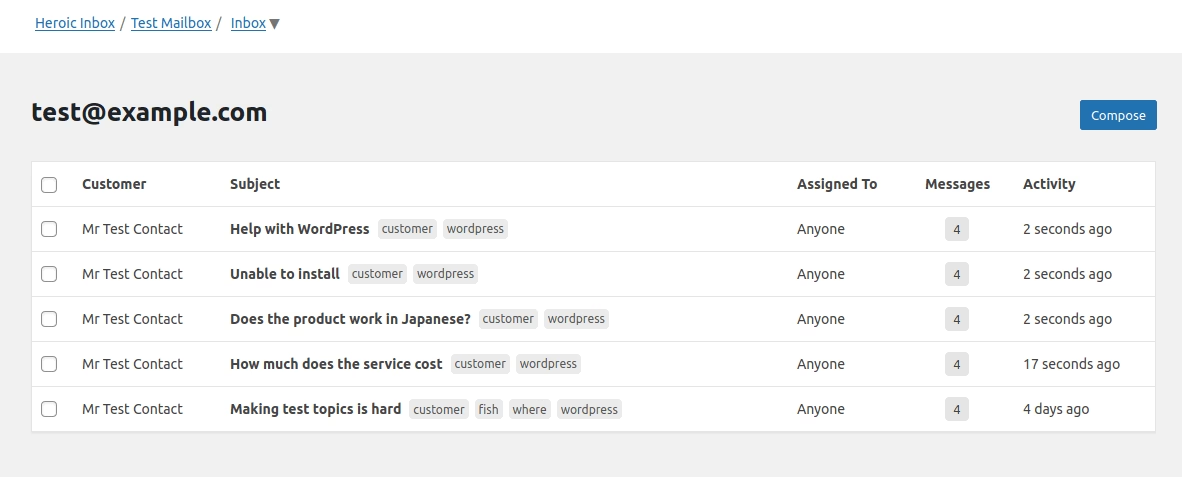
For each ticket, you’ll get an interface to respond to individuals and perform other actions, like adding a tag or internal note:
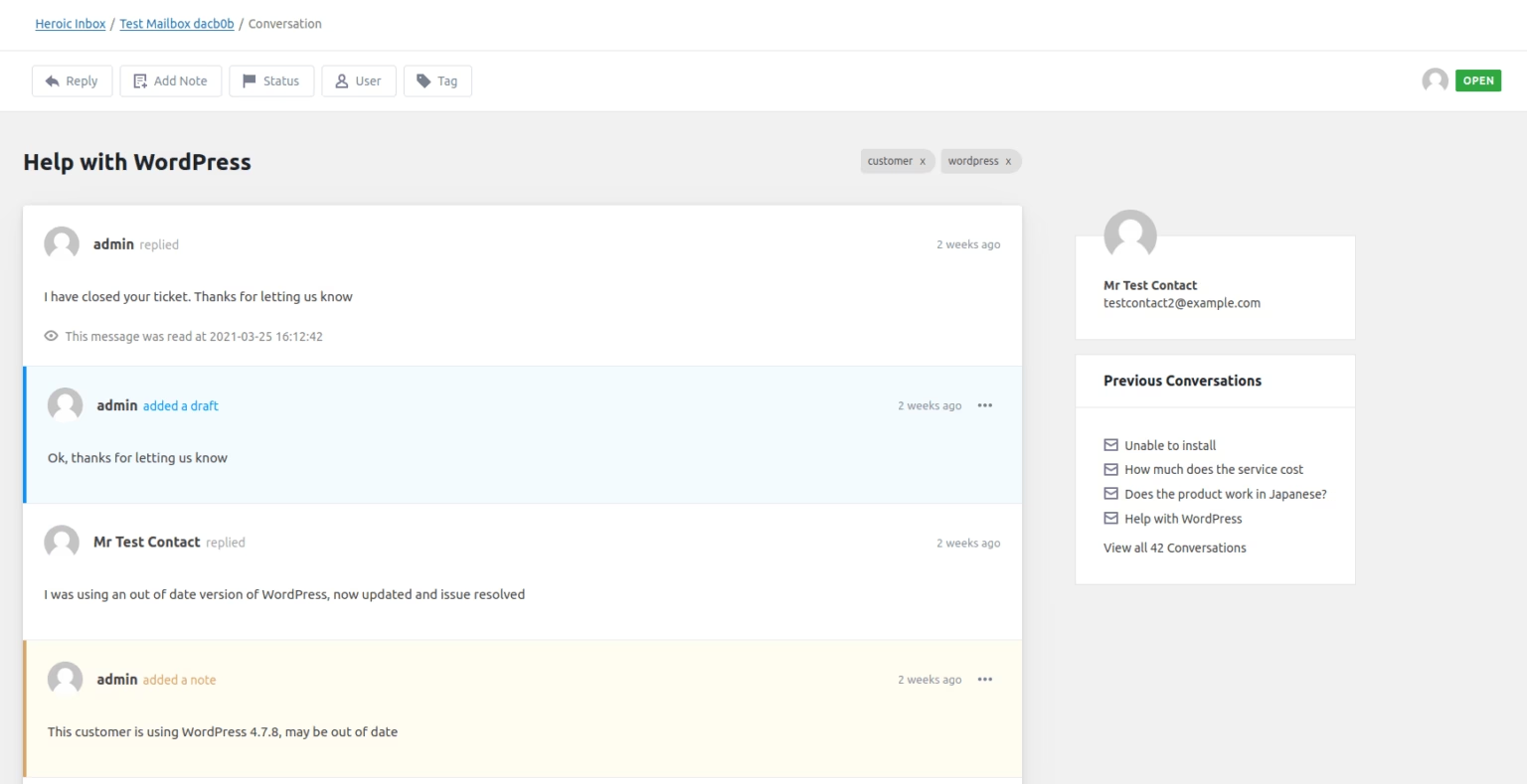
Explore:
Creating DIY Ticketing System with WordPress
14 Best IT Ticketing Systems & Software Compared
The 12 Best WordPress Ticketing Systems — Free & Premium
How To Create a Support Ticket Form
2. Omnichannel Support
A good help desk should support multiple different channels so that you can centralize all your communication in one spot. Customers should be able to use different forms, email addresses, and other communication methods.
No matter where the communication comes from, it should show up as a ticket in your help desk so that your staff can respond from one spot.
3. Staff Management
If you’re the only person responding to customers, you might not need this. But if you have a team responding to customers, you need a way to manage all of those team members and make sure that tickets are routed and assigned to the right people.
Your staff should also be able to transfer tickets if needed and communicate with internal notes that are only visible to team members.
4. Automation
A good help desk doesn’t just facilitate manual work, it should also offer automation features to help you work more effectively. For example, you should be able to automatically apply tags based on a topic, route incoming tickets to the right person, use canned responses to speed up replies, and more.
Your help desk should also be able to automatically identify high-priority issues and make sure they get the attention that they deserve.
5. Customer Data
Your help desk should also provide information on your customer in the ticket so that you can more easily respond. For example, if you have a help desk for an eCommerce store, you should be able to easily view a customer’s order history when you’re responding to a ticket. This will help you save time and access important context for your responses.
Similarly, you should be able to quickly see previous conversations – you can see how it might look in the sidebar on the right:
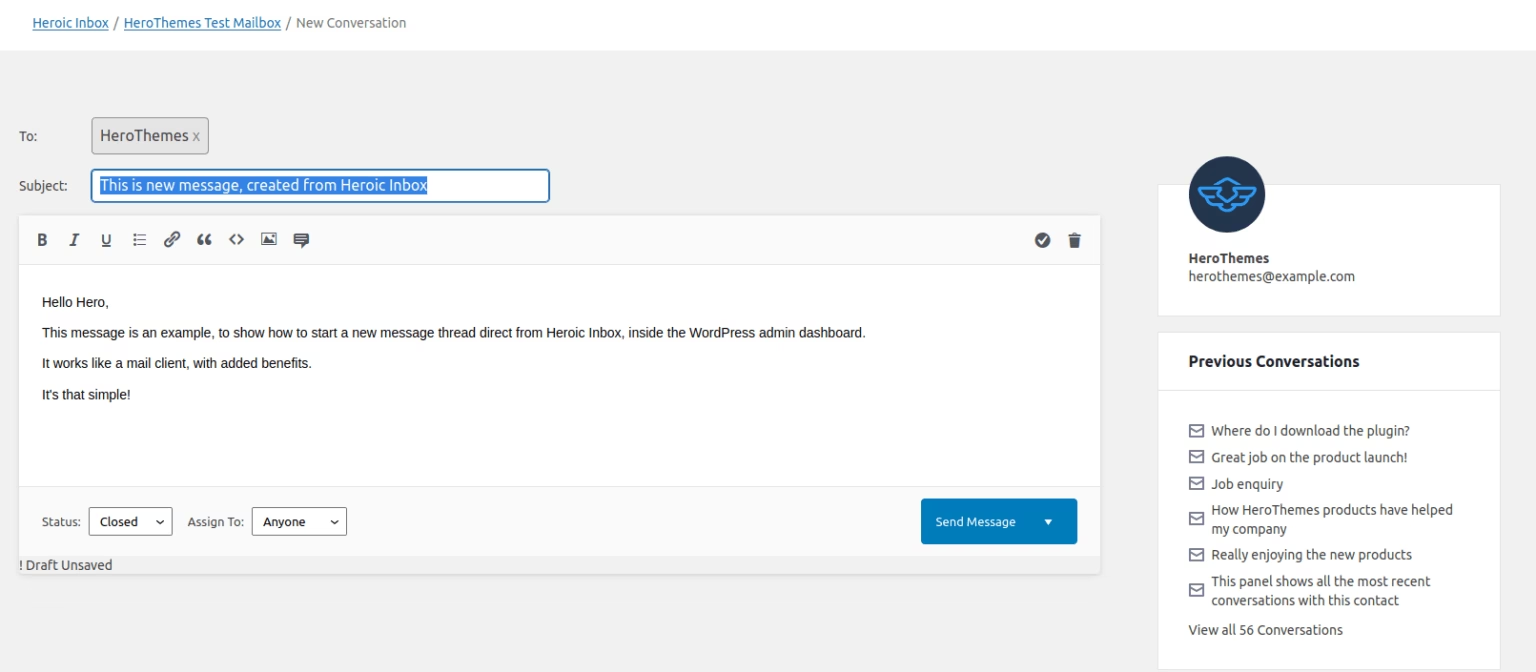
6. Analytics and Reports
A good help desk will also help you learn more about your customers and support staff. You should be able to track metrics such as average response time, the number of tickets that have been answered, customer satisfaction, and more.
Benefits of Using a Help desk
Want to take your customer support to the next level?
A help desk is where you should begin. We have already touched on how help desk skills contribute to your business. Now let’s examine each in more detail.
1. Improve the Effectiveness and Efficiency of Your Support
The main benefit of using a help desk is that it helps you improve the efficiency and effectiveness of your support.
For example, having access to all your different emails and support channels in one spot eliminates the need to jump around between different interfaces. Similarly, automation features help you respond more quickly to those messages and make sure they’re routed to the right spot.
But a help desk doesn’t just help you work faster, it also helps you work better. For example, being able to instantly see a customer’s history gives you valuable context that you can use to offer better, more tailored support to that customer.
2. Single unified support channel
Do you know what annoys a buyer the most? Moving from one support channel to another and asking the same question again and again.
If you offer customer service through various platforms like telephone, text message, live chat, mail inboxes, or social platforms, using a help desk system will let you merge your communication platforms under one roof.
You will also have the buyer’s past information for reference. This will allow you to provide a smooth multichannel experience.
3. Deliver Fast Customer Service
Buyers don’t like any delay, whether they are in a phone conversation, email thread, or queuing outside a store. They need prompt replies from your brand.
In fact, Khoros did a survey and found that 79%2 of buyers wish to get a quick answer when approaching a company.
So, your support representatives can’t afford to waste time navigating through different browser windows or digging past communication when preparing a reply.
Here’s how help desk or customer service software can help in this regard:
- It collects all user chats on a single tab
- It tags support requests for a quick glance at the problem
- It organizes the requests for team members
This enables you to give customers speedy and relevant assistance.
4. Improved Team Productivity
A help desk solutions comes with a number of automation tools to reduce your employees’ overhead and make the most of their help desk skills.
These include:
- Out-of-office auto responders
- Workflow and assignment automation
- Ticket allocation
Not just that. It allows communication among members from different departments and locations. And it makes sure everyone working on your help desk has the same understanding. This results in enhanced employee productivity.
5. Deliver Personalized Communication
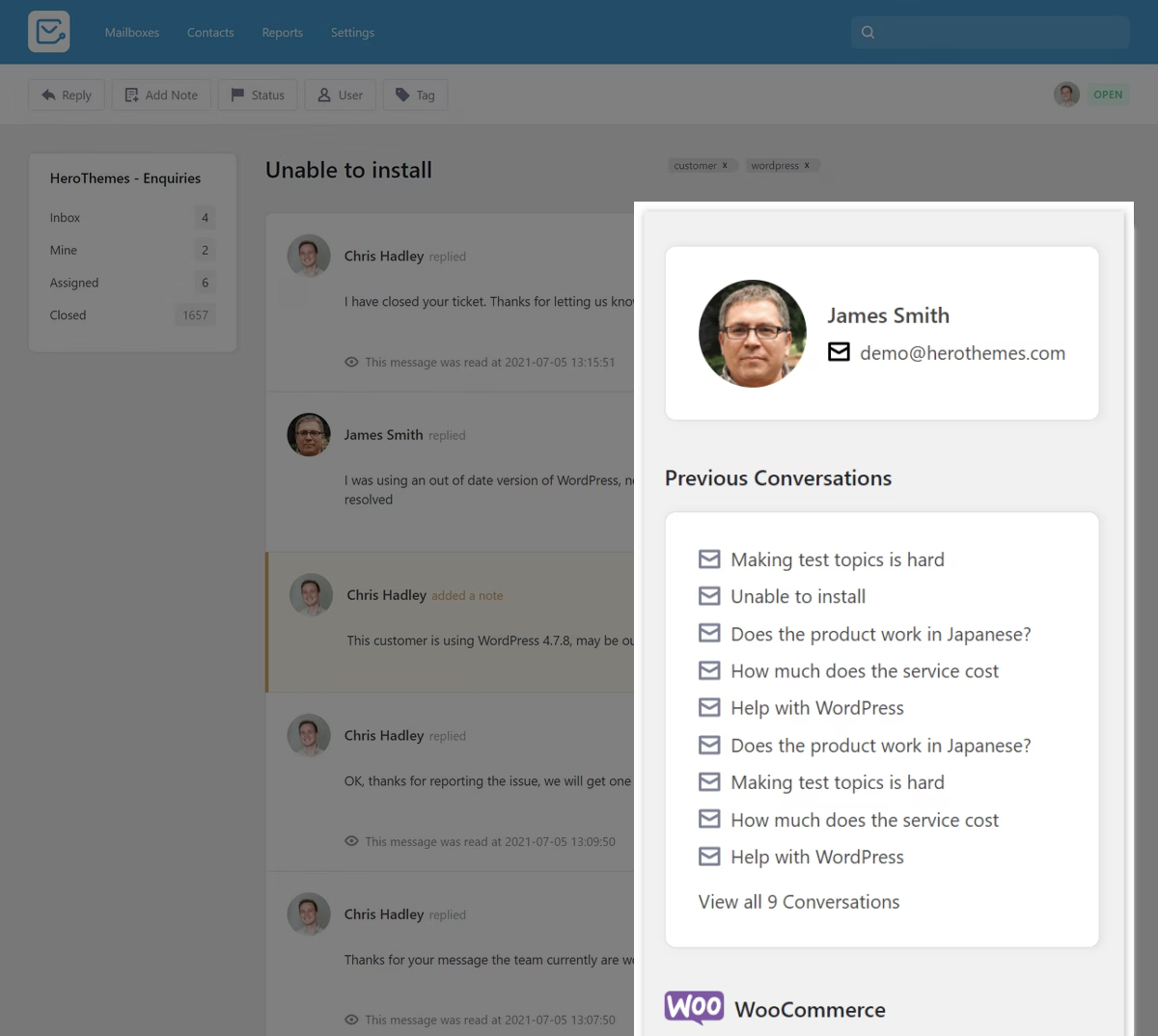
The right help desk software can help you keep every detail or chat of your buyer in a particular location. You can check the issues they contacted you about before and the responses provided to them.
As a result, it wouldn’t matter which help desk representative continues the chat. They would interact with customers smoothly without any discrepancies.
6. Improve Customer Satisfaction
The benefits above also tie tightly to increasing customer satisfaction.
If customers can get faster responses to their questions and issues, they’ll be happier than if they had to wait. Similarly, they’ll be happy that they don’t have to provide unnecessary information because you and your support agents already have that context.
For example, instead of needing to ask the customer to provide their order number or list the items they’re having issues with, you can instantly see that information in your help desk. This reduces the effort and friction required for your customers to get the support they want.
7. Get Valuable Team Performance Data
If you utilize different mailboxes for customer communication, it’s challenging to monitor the amount, types, and successful handling of support tickets.
This data is important because it assists you in keeping track of the effectiveness of every customer service employee in particular and the support team as a whole. It also enables you to set realistic standards for new recruits. A help desk tool will help you get this data.
8. Scale More Effectively
Another big benefit of a help desk is that it helps you scale your customer support efforts as your business grows. When you’re just getting started, it might be easy to manage all of your customer interactions via your email inbox.
But once you grow to a certain point, that approach will no longer be feasible. A help desk can step in to help you keep up with the increased demands on your customer support team.
How To Set Up a Help Desk?
Now that you understand what a help desk is and its benefits, let’s discuss the steps to set up a help desk in your organization.
1. Define Help Desk Goals
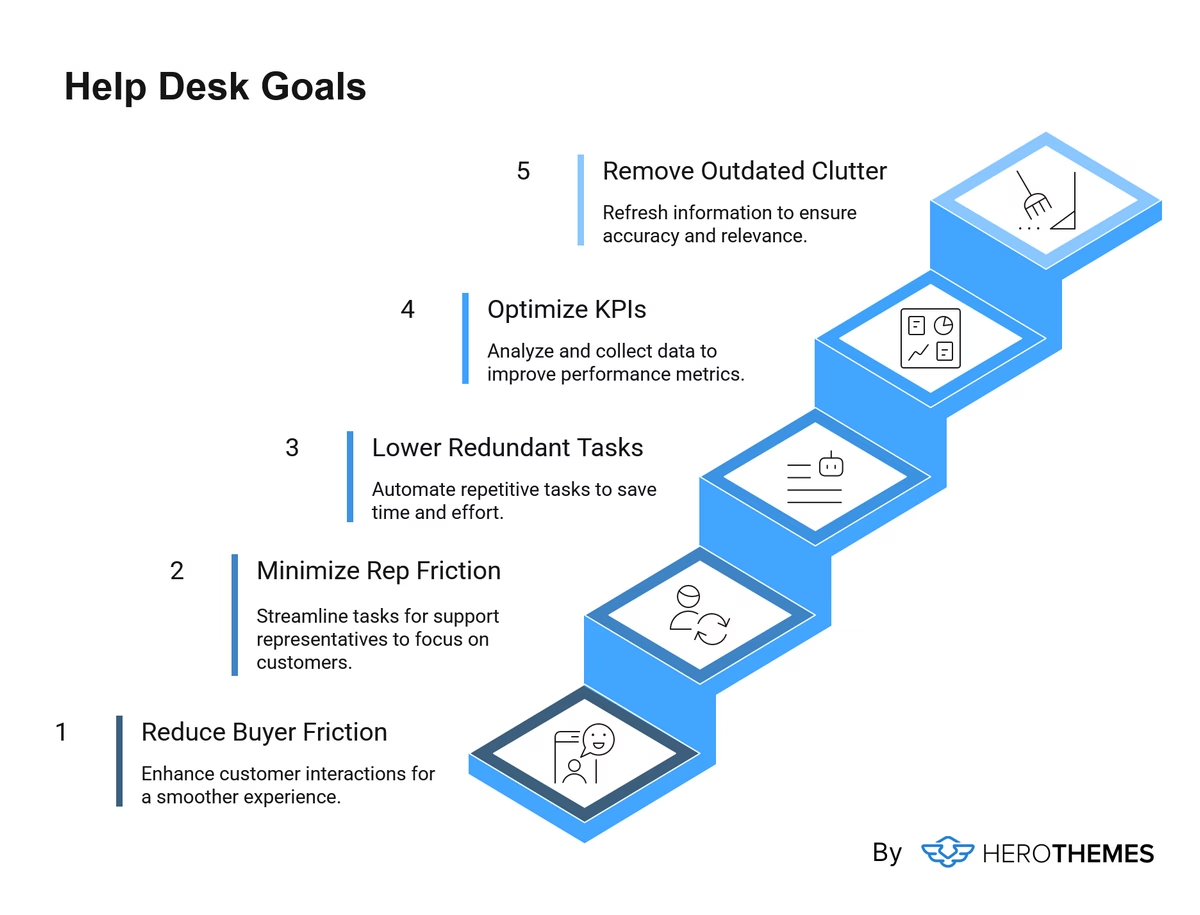
The first step of setting up a help desk support is to establish goals.
Whether you are creating a help desk support from scratch or reviewing the current one, the first thing you need to do is to establish objectives. These could include:
- Reducing friction for your buyers: It is not necessary for your buyers to understand what help desk support is and how your help desk operates behind the scenes in order to receive assistance. The more you can humanize your customer interactions, the more effective your help desk will be.
- Minimizing friction for support representatives: All the additional work items, interactions, and protocols you include in your help desk representatives’ roster may leave them less time for doing their actual job, which is assisting buyers. So you want to organize your help desk system in such a manner that maximum time, effort, and agents’ help desk skills are saved for supporting customers.
- Lowering redundant tasks: Any task that you or your support representatives do repeatedly has room for optimization. For example, you can automate customer service tasks such as holiday notifications or assigning specific incoming tickets.
- Optimizing your KPIs: You must have an explicit understanding of what you need to analyze. So you can reverse engineer and figure out the data you should fetch from your customer interactions. Once you have these insights, you can build a help desk system that regularly and easily collects the required data.
- Getting rid of outdated clutter: Does your help desk still have obsolete processes or facets, outdated or incorrect cached answers, or profiles of ex-teammates? Helps desks of active support representatives pile up all kinds of technological dust. So one of your goals could be to refresh all of that information to reduce the probability of your team sharing incorrect responses.
2. Build Your Help Desk Support Team Structure
Help desk is a system of humans and tools organized to serve customers. So let’s talk about the people part first.
Help desk support team roles and responsibilities:
| Role | Responsibility |
|---|---|
| Help Desk Manager | Oversees team workload, SLAs, KPIs, and continuous improvement initiatives |
| Service Desk Coordinator | Routes incoming tickets, prioritizes issues, and ensures timely escalations |
| Knowledge Manager | Creates, curates, and maintains internal knowledge base and support documentation |
| IT Trainer / Onboarding Coordinator | Supports employee onboarding with device setup and IT orientation sessions |
| QA Analyst | Monitors ticket resolution quality, ensures compliance with SOPs and SLAs |
| Senior Support Engineer | Handles escalated technical issues, mentors junior agents, and liaises with Tier 3 |
| Support Agent (Tier 1 Technician) | First point of contact for users; resolves basic IT issues and creates tickets |
| Junior Support Technician | Assists with simple hardware/software tasks, follows scripts or checklists |
| Remote Support Specialist | Provides support to remote/hybrid employees for connectivity and tool issues |
| Support Intern / Trainee | Learns core processes, handles low-impact tickets, and assists with documentation |
Here are the help desk skills and roles you will need to form a help desk team:
Help Desk Admin
This is a senior professional in a company who sets up and handles help desk operations and solutions needed for the support agents to offer superior customer service.
Support Manager
This role is generally a specialist who is in charge of fulfilling service level agreements (SLA) and handling customer service management. A support manager is also in charge of all help desk representatives. This person makes sure the tasks are shared evenly among the support team representatives, resulting in outstanding customer service.
Support Agents
These individuals answer customer service inquiries and offer solutions as the company’s representatives. A support agent may be an all-rounder or a subject matter expert. Their key competencies may include tech assistance, IT help, or assistance in company processes based on the requirement.
3. Select the Best Help Desk Software
You can use the list of features we covered below to create your evaluation checklist. But if you need help in making a decision, we highly recommend a combination of WordPress and Heroic Inbox, one of the most convenient help desk solutions.
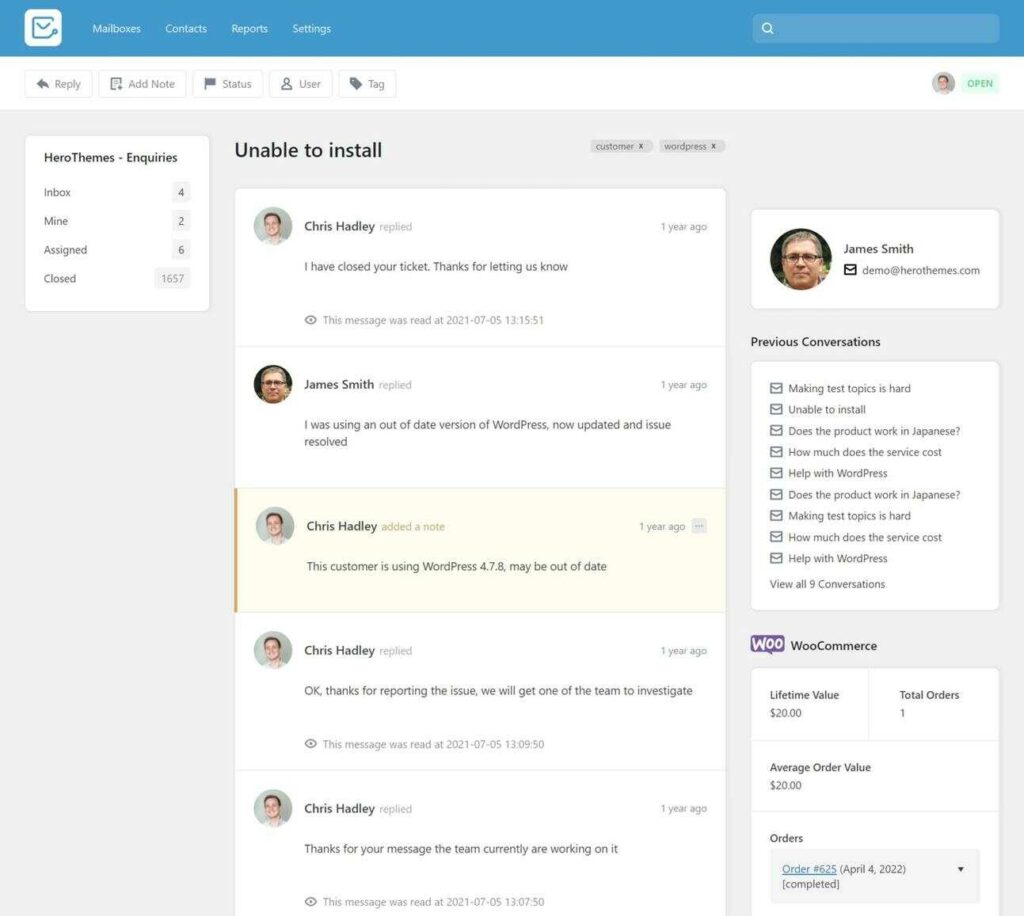
Heroic Inbox is a shared mailbox and ticketing tool that removes interruption and simplifies customer service management for the support team. Also, it is inexpensive in comparison to other help desk solutions, the majority of which use the more expensive SaaS model.
The primary benefit of this ticketing tool is that you can handle all your sales, customer service, collaborations, and other mailboxes from one location.
Not just that. With Heroic Inbox It’s easy to create a shared inbox Gmail or GSuite. Once you do that, Heroic Inbox will begin transferring your emails to the WordPress dashboard, and you can start replying to these emails.
If you own a WooCommerce based website, Heroic Inbox can directly extract every buyer’s information from your sales data.
To choose the right help desk software:
- Make sure it is easy to use
- Has ticket management capabilities
- Supports multiple channels and integrations
- Automation abilities
- Customization
- SLA management
- Performance reporting
- Team collaboration features.
The second element of a help desk is the software you will employ to handle and simplify help desk activities.
A help desk support is a system that companies employ to arrange, monitor, and handle their customer support interactions. It enables your help desk representatives to answer each problem in a systematic manner and without delay.
A help desk software is also known as ‘customer support software’ or ‘support ticketing system.’
The majority of businesses that are setting up their customer service desk from scratch start with a shared inbox or tools like MS Excel. There are many help desk software available in the market. So it can be difficult to identify the best option.
Consider answering the following questions before you make a decision about help desk software:
1. What are our target customer communication channels?
What are the primary avenues through which you will get customer service-based requests? And do your customers need a self-help platform to post and track their support requests?
2. How much can we spend?
When setting aside funds for deploying new software, take into account the money needed upfront and in the near future when assessing help desk software. For instance, the pricing of $50 per month for one agent seems viable for a team of two. But will the cost still be reasonable if it expands to 20 or 200?
3. How many people will use it, and what are their KPIs?
What will be the headcount of the employees who would use the help desk software as support representatives? What findings or performance indicators do you wish to view to assess their help desk skills?
4. What level of customer support do we need?
Prior to buying a help desk support solution, check out their means of providing customer service. For instance, are they providing just email support? What mediums are they using to provide assistance? Are their knowledge base and help guides useful?
An excellent method to examine this is by submitting a request to their own help desk and testing the reach and effectiveness of their customer support.
5. Which existing apps do we need to support?
Your business may be using certain solutions already. These tools, when connected to your help desk, will free up hours, and simplify the process of managing support requests for your help desk representatives.
For example, a support ticketing solution is frequently integrated with the company solutions mentioned below:
- eCommerce solutions – For example, Magento, Shopify, and WooCommerce
- Sales CRM tools – For example, Microsoft Dynamics and Salesforce
- Telephony solutions – For example, Aircall and RingCentral
- Remote desktop management systems – For example, LogMeIn and Rescue
6. What functionalities are critical for your business?
A powerful help desk software must allow you and your support representatives to offer customer service in a streamlined and efficient way. So creating a checklist of your must-have and nice-to-have features is a must when evaluating different options. Here are the core features to consider:
7. Ease of use
Your support agents may be continuously changing. So the new hires to the support department should be able to learn what help desk support is and its functionalities fast to begin assisting buyers.
Then, it’s important that your helpdesk solution is simple and easy to use. It should not baffle your help desk representatives with a complicated look and feel.
8. Ticket management
A ticket (also called a case) is a word that refers to a particular customer inquiry, problem, or grievance. Check the capability to convert inbound inquiries to help desk tickets to arrange, allocate and bring tickets to an effective settlement or completion.
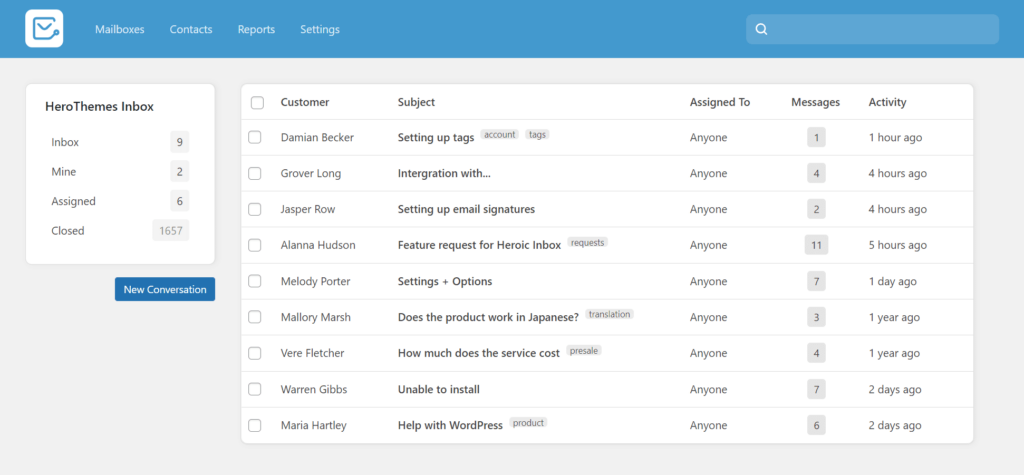
Automatic ticket routing and allocating, classifying and sorting tickets based on importance, handling flexitime, and useful SLA (or Service-level agreement) handling are important functionalities to consider for help desk ticketing.
Explore:
How To Create a Ticketing System From Scratch
12 Free and Paid WordPress Ticketing plugins of 2025
9. Support across multiple channels
These days, buyers expect their preferred businesses to be accessible on various mediums like email, live chat, texting services, social networks, telephone, or websites for quick support.
Consider help desk systems that can handle inquiries from various channels and provide the option to shift from one avenue to another effortlessly.
10. Automation capabilities
The majority of customer support tickets require the same answers. With help desk support functionalities like auto-responder, auto-assignment, predetermined answers, automation triggers, or processes, ticket management gets highly effective.

11. Branding and customization
The ideal system should allow you to change the interface or appearance of your help desk to merge with your website’s branding. And you should also be able to customize support representatives’ views and permissions based on their duties.
12. 3rd-party integrations
If you utilize indispensable company tools like CRM, G Suite, Slack, or WooCommerce on a regular basis, connecting your help desk system with these platforms makes customer communications simpler.
The majority of help desk support tools provide straightforward syncing with widely used solutions. This assists you in getting a better idea of the wishes and requirements of your buyers.
13. SLA management
According to a Microsoft report, 33%3 of buyers believe that the critical component of effective customer service is having their problems solved in one conversation.
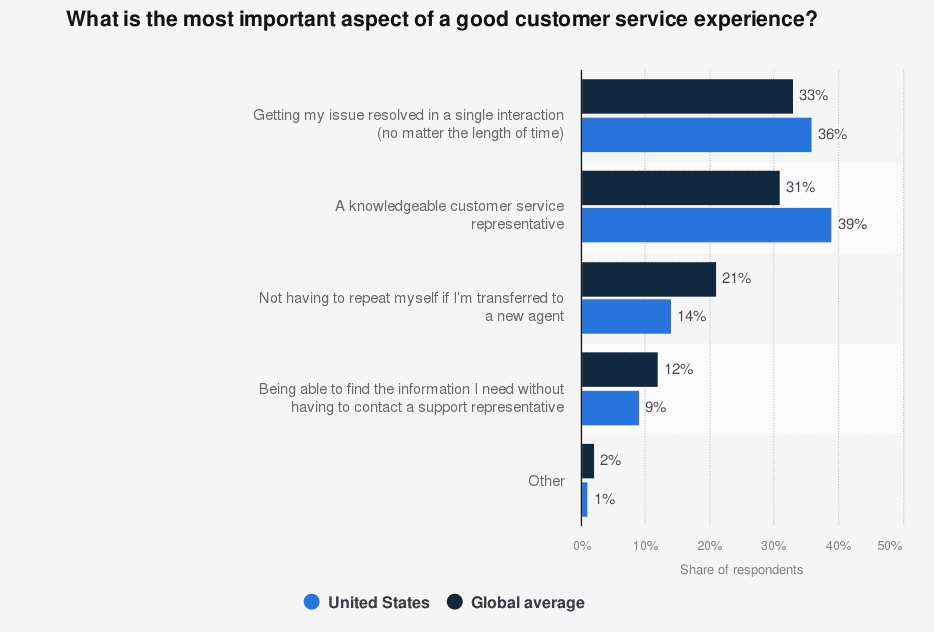
Image source: Statista
Service level agreements, or SLAs, are objectives that businesses define to satisfy buyers. For instance, how quickly the customer gets the first reply? What will be the expected timeframe to fully solve a customer problem?
A great help desk support solution will tell the business the number of times they achieve their set objectives. Not just that. It will also notify or warn the business when tickets may violate their service level agreement.
14. Analytics data
Analytics offers live information on ticket patterns for improved service management and allows you to view crucial support agent evaluation indicators. These include FCR or First Contact Resolution and response times on an easy-to-use console or dashboard.
You can also have collective data on support agent evaluation and their help desk skills to be sent directly to your email.
15. Team collaboration
Your help desk representatives will require a space to team up with other people in and out of your organization.
With effective teamwork abilities, your crew can use their help desk skills to establish the tone, provide valuable criticism on tickets and allow other collaborators to notify you every time they solve problems.
4. Configure How You Receive Support Requests
You need to plan how you receive support tickets. Common methods include creating request forms, connecting your inboxes, checking third-party integrations, and evaluating your knowledge base.
Now that you have chosen a help desk support tool, it’s time to figure out a way to determine how customers will raise tickets. Here are the methods you can implement:
Step 1: Create Forms for Customer Queries
Build and place customer contact forms in strategic locations and across your website. And share links to those forms on your chosen channels and social media profiles.
You should also examine the form for simplicity, shortness, and correctness. Also, make sure the form submission is working properly.
We compared some of the best WordPress form builder plugins to make your job easy.
Step 2: Connect Your Email Inboxes With the Help Desk System
You may already have designated email addresses for customers to contact sales, support, billing, and so on. If not, you can create these from scratch. And ensure none of your emails end up in your spam folder or are sent to the old email accounts that are no longer relevant.
Next, import data from these inboxes to your help desk software. Heroic inbox, for instance, offers a centralized dashboard in which you can organize and reply to emails that come to different customer service mailboxes.

The tool lets you assemble all your communication strings systematically in one place in your WordPress dashboard.
And your help desk representatives don’t have to repeatedly switch from one screen to another because now they can manage all their email threads within WordPress.
Step 3: Setup Third-Party Integrations
See if you use any 3rd-party tools that need to be integrated with your help desk platform. You can try out the tools you want to use and discard the ones you don’t need anymore.
Step 4: Update Your Contact Info
If you run a knowledge base, you may have “contact us” links on several pages that you need to update. If not, check where you can add them to provide the best experience to users.
But if you don’t have a knowledge base already, no worries. You can always build a new one. You can create a knowledge base with Heroic KB, another top-notch plugin offered by the same company that made Heroic Inbox.
5. Manage and Organize Conversations
You should have a process that is easy to understand. So that everyone in the support staff is clear on their tasks and duties and handles the requests assigned to them according to their help desk skills.
You can do this in the following ways:
Set Up Categorization and Team Permissions
Determine which help desk representatives can access particular requests and permit only them to see those tickets.
With Heroic Inbox, for example, you can permit certain users and teams to view their allocated email inboxes or support cases.
Also, tag the tickets properly, so that the customer support team doesn’t waste time locating them. Make sure there are no duplicate tags or categories.
Automate Workflows
Put automation on recurring chores to minimize the work pressure on the customer service team for better service management. If you already have some automation triggers in place, review them again for accuracy and usefulness.
Configure Ticket Assignment
In this step, determine how tickets will be assigned to different users and teams and make sure your help desk aligns with these rules. It guarantees airtight responsibility as you can specify the scope.
Heroic Inbox, for example, can help you allocate support tickets or mailboxes to particular support agents.
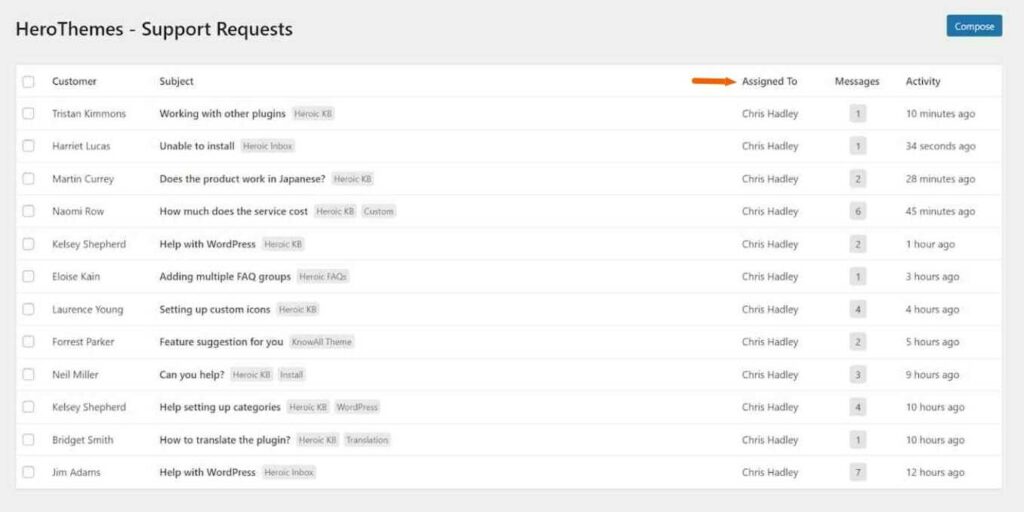
When combined with email routing, you can attain a high level of authority over which agents or teams get the support requests.
Not just that. You will have features like making team notes and internal messaging to bind your team together.
Document Your Process
Take out some time to record or write the entire procedure that you have determined in the previous steps.
Documenting your standard operating procedures will benefit you at the time of hiring and bringing your current support staff up to speed. Here’s what you can note:
- What labels and tags should your team utilize, and under what circumstances
- How to pass over a case to other support representatives and when to do so
- Nomenclature and guidelines for employing and handing canned responses
Communicating such standards with your entire support staff increases efficiency and improves service management.
Also, it minimizes the probability of your newly structured help desk getting crumbled under the mountain of wrongly used labels and busted processes.
6. Bring Consistency to Your Outgoing Messages
The next step is to determine the ways to improve the accuracy, usefulness, and tone of your regular messages to customers. Here’s how:
Review Your Email Copies and Designs
You may already have some email templates that you send to customers. Consider examining those copies for writing style, embedded links for correctness, and branding on templates. If not, you can create them from scratch.
Also, remember to review the email signatures and footer content your customer service staff puts on their emails.
Prepare or Update Your Canned Responses
To send accurate and productive messages, and save your team from writing the same emails again and again, consider preparing some standard responses in advance. And check your saved replies for the correct and latest information.
Ensure that the responses follow your recent guidelines and have appropriate tags so that agents can easily get them.
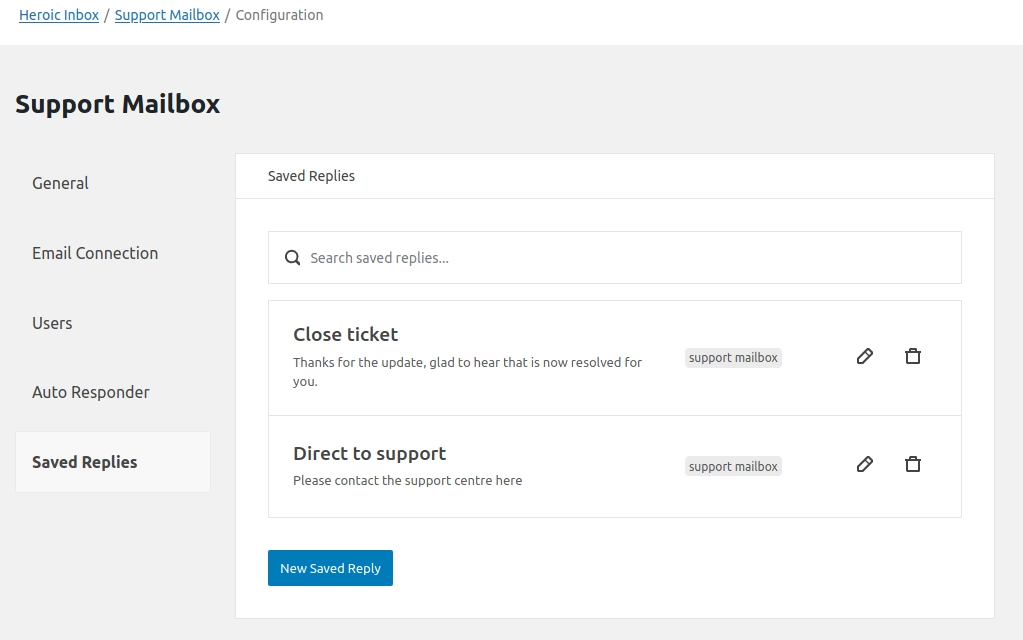
The majority of help desk tools, such as Heroic Inbox, allow you to integrate canned responses and layouts in communication. As a result, this enables you to reply quickly and uniformly.
7. Test Your New Help Desk
From learning what is help desk to creating one from scratch, you have now come a long way.
Once you have created your help desk support system and aligned your support staff accordingly, conduct a few trials to ensure that the system is functioning as it should.
For example, you can pose as a customer and submit a few test requests to your help desk so that your support staff can respond utilizing the latest protocols. For starters, you can examine the following:
- Automation triggers and processes: Create and send test requests that must activate your automated workflows to ensure they are operating as you planned.
- Common tags and labels: Try sending query emails that mimic actual customer problems that surface on a regular basis to make sure you have already generated the common categories and labels.
- Different categories of buyers: Do you divide your arriving support tickets based on the types of consumers? If yes, then create test queries for every group to ensure that only appropriate users are seeing them.
- Customer experience: Lastly, reply to the emails received in your inbox and evaluate the user experience. Check if emails are delivered properly and have the correct information or not.
8. Keep Refining Help Desk Performance
Improving your help desk support system is an ongoing task. And switching to new help desk software gives you an opportunity to streamline your operations and eliminate redundant information.
If you have followed all the steps correctly so far, you probably established performance metrics you want to track your support team’s help desk skills. If not, it’s not too late.
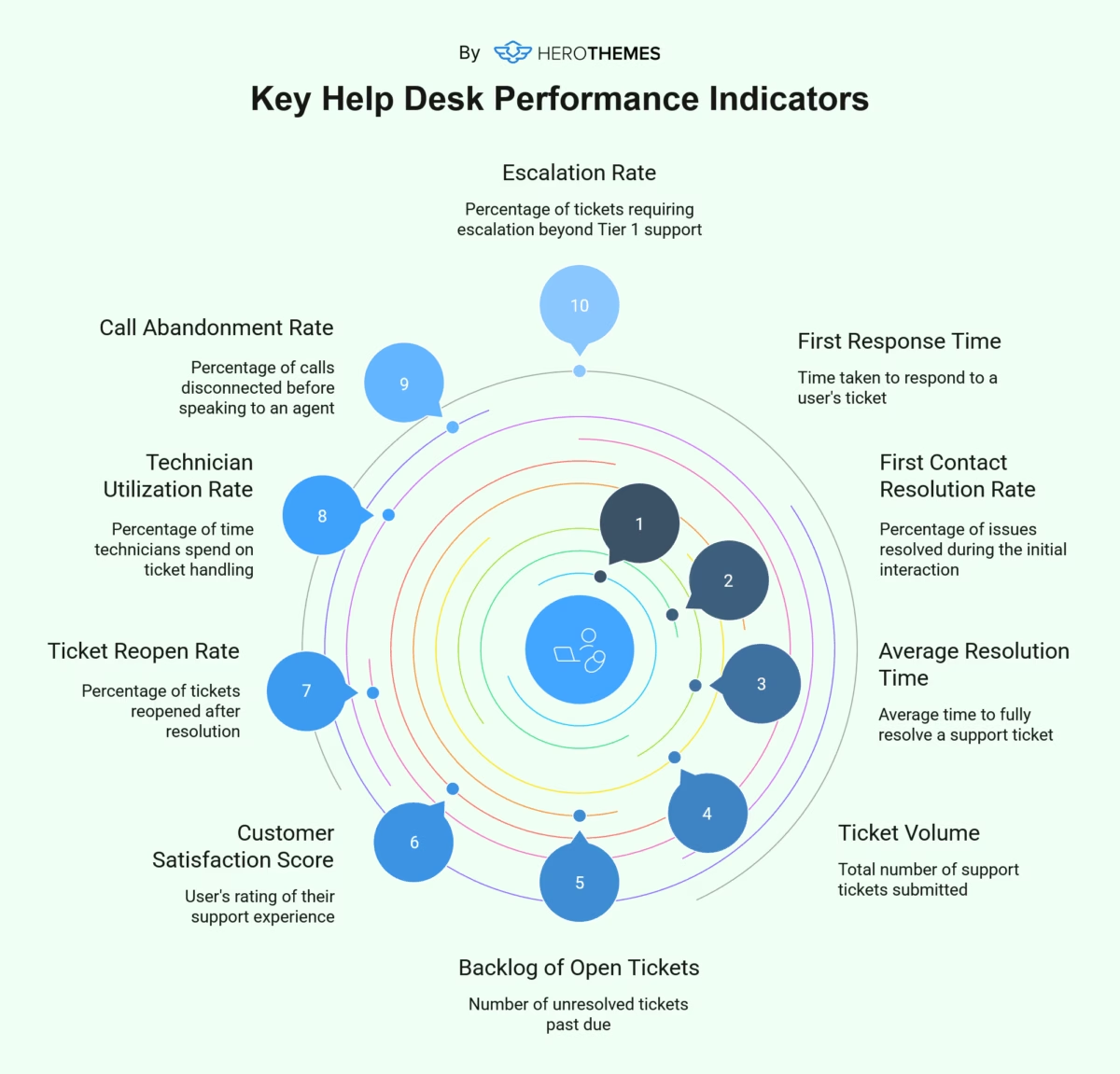
See if your help desk software can track performance indicators such as:
- First response time
- Resolution rate
- Customer satisfaction score
Then use this data to keep improving the efficiency of your help desk support.
Frequently Asked Questions about Help Desk
Here are our most frequently asked questions related to help desk support, along with their answers.
What Does a Help Desk Do?
The job of help desk support is to collate and organize all the customer service requests and conversations across different mailboxes and channels into a single dashboard. This provides customer support representatives the help desk skills to handle customer requests and complaints quickly and easily.
What Is a Help Desk Ticket?
A help desk ticket (also known as a customer support case, customer service ticket, or just ticket) refers to a specific customer problem, complaint, or question. It is created within a help desk system when a customer makes the first contact with his particular issue.
On the same note, ticket management is the process of handling the entire journey of a ticket from its initial creation to resolution.
Help Desk vs CRM
When talking about tools to help you interact and engage with your customers, another common tool you’ll find is a CRM, short for customer relationship management.
The key difference is that a CRM software is more focused on sales and account management, while a help desk is more focused on offering support.
Typically, a CRM will assign a single salesperson or account manager to each customer and that person will manage all interactions with the customer.
A help desk, on the other hand, is more focused on providing support to customers and responding to inquiries. You might have multiple agents or teams geared up to respond to inquiries as they come in.
The two types of tools can be complementary. For example, you could use a CRM for sales and account management while also using a help desk to respond to customer inquiries and offer support.
What Is the Difference Between a Help Desk and a Service Desk?
Many people use both these terms interchangeably. But there is a minor difference between them.
The term help desk support encompasses any type of support for which a customer reaches out to a company. It includes functions such as ticket management, knowledge base, and multi-channel support.
A service desk, on the other hand, is used mostly for IT service management pertaining to both employees and buyers. Its key functions are incident management, asset management, and change request management.
What Is Help Desk Software?
The term help desk software (also known as support ticketing systems) is used for tools that companies use to receive, organize, and handle customer support communications.
With a help desk system, you can bring all your support requests to one location for easier organization and management. This allows help desk representatives to address and solve customers’ questions fast.
What Are the Best Help Desk Software?
The best help desk software available include Heroic Inbox, Kayako, Zendesk, Freshdesk, Jira, HappyFox, and Spiceworks.
Check out our in-depth guide to the best WordPress help desk plugins, including free and premium options.
Wrapping Up
We hope this guide has provided you with an elaborate answer to what is help desk, how to set it up, and other questions to help elevate your level of customer service.
The right help desk system can go a long way in letting your team collaborate to their maximum potential, as well as provide effortless customer support.
The majority of help desk solutions provide a free trial or money-back guarantee for a certain duration or for a specific number of people. Make the most of this limited time and try out the help desk on a daily basis to test its usability.
Here at HeroThemes, we strongly recommend a combination of WordPress and Heroic Inbox. With a simple user interface and a powerful set of features, your agents can start with an optimized help desk and begin handling customer problems in a jiffy!
Further Reading
11 Types of Customer Service: Complete Guide
10 Best Customer Support Tools for All Needs
14 Best IT Ticketing Systems of 2025
Mentioned Resources in This Guide
- Status Quo in Customer Experience by customerthink ↩︎
- Must-know customer service statistics – Khoros survey ↩︎
- State of global customer service report ↩︎



